Assessment Task and Scenarios
VerifiedAdded on 2022/12/28
|21
|3915
|29
AI Summary
This document provides information about assessment tasks and scenarios related to IV medication administration, electrolyte replacement, acid-base imbalance, and more. It covers topics such as drug toxicity, contraindications, precautions, and the difference between side effects and adverse reactions. It also includes examples of different types of drugs and their definitions.
Contribute Materials
Your contribution can guide someone’s learning journey. Share your
documents today.

Running head: ASESSMENT TASK AND SCENARIOS
ASESSMENT TASK AND SCENARIOS
Name of the Student
Name of the University
Author’s Note
ASESSMENT TASK AND SCENARIOS
Name of the Student
Name of the University
Author’s Note
Secure Best Marks with AI Grader
Need help grading? Try our AI Grader for instant feedback on your assignments.
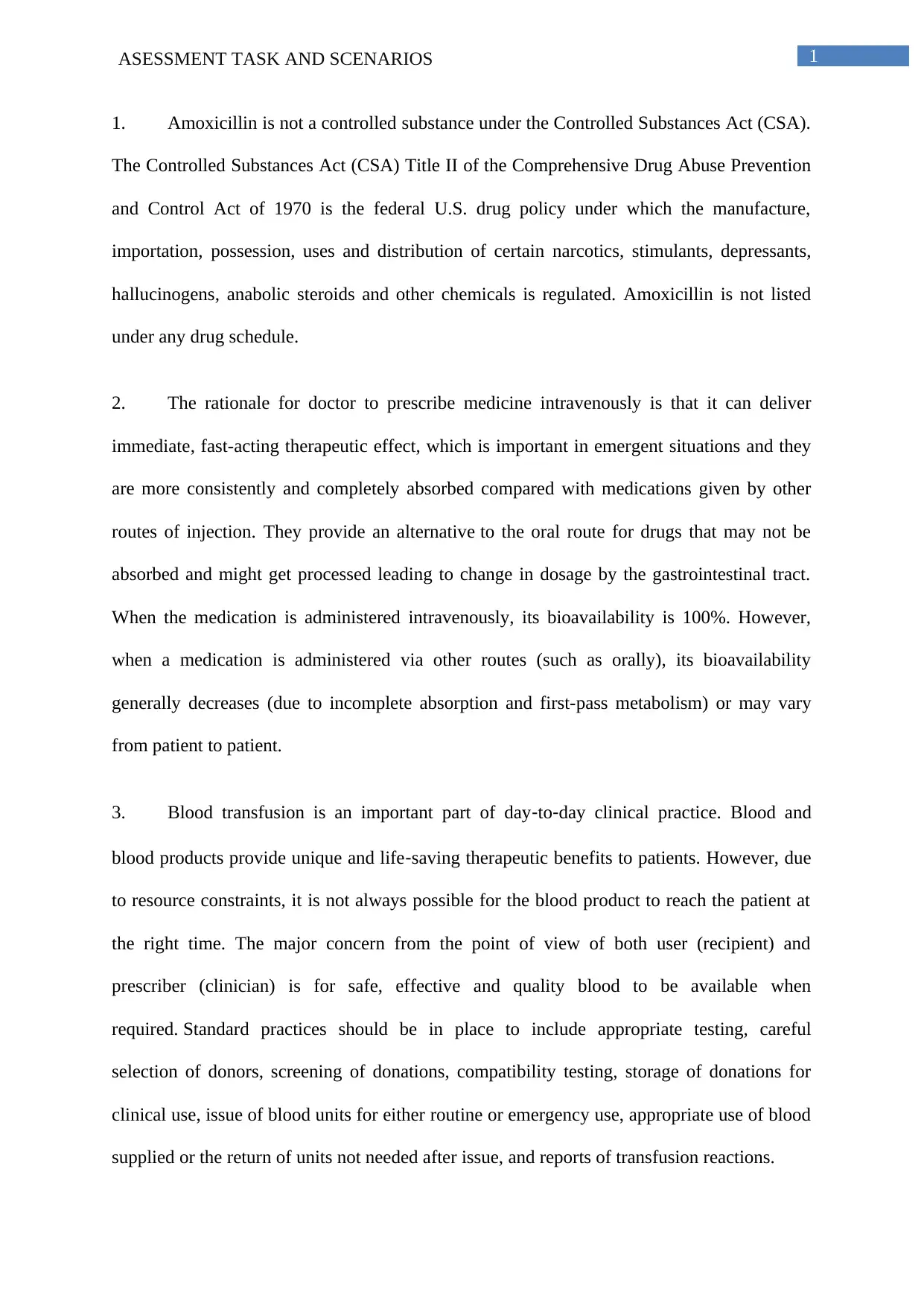
1ASESSMENT TASK AND SCENARIOS
1. Amoxicillin is not a controlled substance under the Controlled Substances Act (CSA).
The Controlled Substances Act (CSA) Title II of the Comprehensive Drug Abuse Prevention
and Control Act of 1970 is the federal U.S. drug policy under which the manufacture,
importation, possession, uses and distribution of certain narcotics, stimulants, depressants,
hallucinogens, anabolic steroids and other chemicals is regulated. Amoxicillin is not listed
under any drug schedule.
2. The rationale for doctor to prescribe medicine intravenously is that it can deliver
immediate, fast-acting therapeutic effect, which is important in emergent situations and they
are more consistently and completely absorbed compared with medications given by other
routes of injection. They provide an alternative to the oral route for drugs that may not be
absorbed and might get processed leading to change in dosage by the gastrointestinal tract.
When the medication is administered intravenously, its bioavailability is 100%. However,
when a medication is administered via other routes (such as orally), its bioavailability
generally decreases (due to incomplete absorption and first-pass metabolism) or may vary
from patient to patient.
3. Blood transfusion is an important part of day‐to‐day clinical practice. Blood and
blood products provide unique and life‐saving therapeutic benefits to patients. However, due
to resource constraints, it is not always possible for the blood product to reach the patient at
the right time. The major concern from the point of view of both user (recipient) and
prescriber (clinician) is for safe, effective and quality blood to be available when
required. Standard practices should be in place to include appropriate testing, careful
selection of donors, screening of donations, compatibility testing, storage of donations for
clinical use, issue of blood units for either routine or emergency use, appropriate use of blood
supplied or the return of units not needed after issue, and reports of transfusion reactions.
1. Amoxicillin is not a controlled substance under the Controlled Substances Act (CSA).
The Controlled Substances Act (CSA) Title II of the Comprehensive Drug Abuse Prevention
and Control Act of 1970 is the federal U.S. drug policy under which the manufacture,
importation, possession, uses and distribution of certain narcotics, stimulants, depressants,
hallucinogens, anabolic steroids and other chemicals is regulated. Amoxicillin is not listed
under any drug schedule.
2. The rationale for doctor to prescribe medicine intravenously is that it can deliver
immediate, fast-acting therapeutic effect, which is important in emergent situations and they
are more consistently and completely absorbed compared with medications given by other
routes of injection. They provide an alternative to the oral route for drugs that may not be
absorbed and might get processed leading to change in dosage by the gastrointestinal tract.
When the medication is administered intravenously, its bioavailability is 100%. However,
when a medication is administered via other routes (such as orally), its bioavailability
generally decreases (due to incomplete absorption and first-pass metabolism) or may vary
from patient to patient.
3. Blood transfusion is an important part of day‐to‐day clinical practice. Blood and
blood products provide unique and life‐saving therapeutic benefits to patients. However, due
to resource constraints, it is not always possible for the blood product to reach the patient at
the right time. The major concern from the point of view of both user (recipient) and
prescriber (clinician) is for safe, effective and quality blood to be available when
required. Standard practices should be in place to include appropriate testing, careful
selection of donors, screening of donations, compatibility testing, storage of donations for
clinical use, issue of blood units for either routine or emergency use, appropriate use of blood
supplied or the return of units not needed after issue, and reports of transfusion reactions.
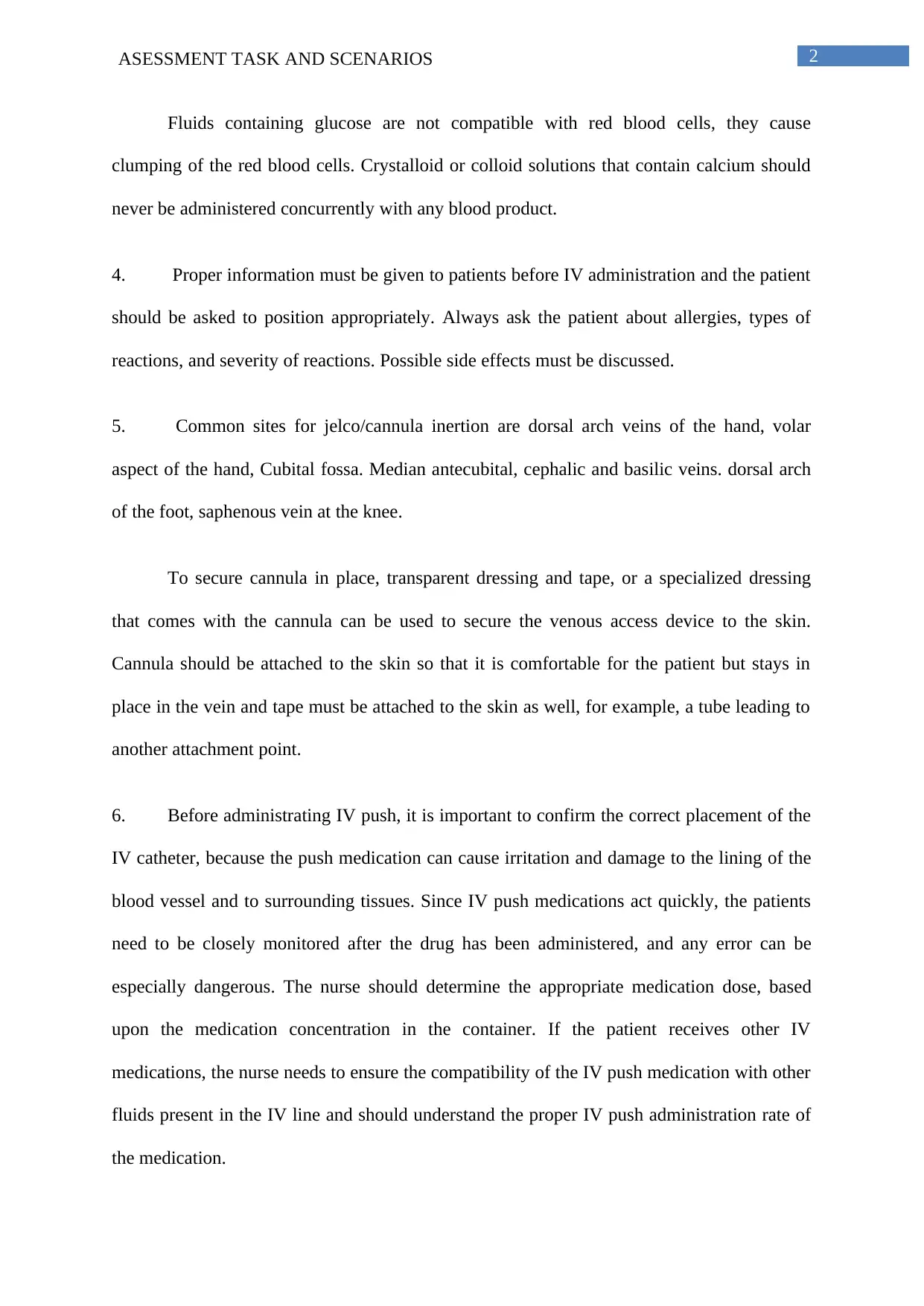
2ASESSMENT TASK AND SCENARIOS
Fluids containing glucose are not compatible with red blood cells, they cause
clumping of the red blood cells. Crystalloid or colloid solutions that contain calcium should
never be administered concurrently with any blood product.
4. Proper information must be given to patients before IV administration and the patient
should be asked to position appropriately. Always ask the patient about allergies, types of
reactions, and severity of reactions. Possible side effects must be discussed.
5. Common sites for jelco/cannula inertion are dorsal arch veins of the hand, volar
aspect of the hand, Cubital fossa. Median antecubital, cephalic and basilic veins. dorsal arch
of the foot, saphenous vein at the knee.
To secure cannula in place, transparent dressing and tape, or a specialized dressing
that comes with the cannula can be used to secure the venous access device to the skin.
Cannula should be attached to the skin so that it is comfortable for the patient but stays in
place in the vein and tape must be attached to the skin as well, for example, a tube leading to
another attachment point.
6. Before administrating IV push, it is important to confirm the correct placement of the
IV catheter, because the push medication can cause irritation and damage to the lining of the
blood vessel and to surrounding tissues. Since IV push medications act quickly, the patients
need to be closely monitored after the drug has been administered, and any error can be
especially dangerous. The nurse should determine the appropriate medication dose, based
upon the medication concentration in the container. If the patient receives other IV
medications, the nurse needs to ensure the compatibility of the IV push medication with other
fluids present in the IV line and should understand the proper IV push administration rate of
the medication.
Fluids containing glucose are not compatible with red blood cells, they cause
clumping of the red blood cells. Crystalloid or colloid solutions that contain calcium should
never be administered concurrently with any blood product.
4. Proper information must be given to patients before IV administration and the patient
should be asked to position appropriately. Always ask the patient about allergies, types of
reactions, and severity of reactions. Possible side effects must be discussed.
5. Common sites for jelco/cannula inertion are dorsal arch veins of the hand, volar
aspect of the hand, Cubital fossa. Median antecubital, cephalic and basilic veins. dorsal arch
of the foot, saphenous vein at the knee.
To secure cannula in place, transparent dressing and tape, or a specialized dressing
that comes with the cannula can be used to secure the venous access device to the skin.
Cannula should be attached to the skin so that it is comfortable for the patient but stays in
place in the vein and tape must be attached to the skin as well, for example, a tube leading to
another attachment point.
6. Before administrating IV push, it is important to confirm the correct placement of the
IV catheter, because the push medication can cause irritation and damage to the lining of the
blood vessel and to surrounding tissues. Since IV push medications act quickly, the patients
need to be closely monitored after the drug has been administered, and any error can be
especially dangerous. The nurse should determine the appropriate medication dose, based
upon the medication concentration in the container. If the patient receives other IV
medications, the nurse needs to ensure the compatibility of the IV push medication with other
fluids present in the IV line and should understand the proper IV push administration rate of
the medication.

3ASESSMENT TASK AND SCENARIOS
7. The 8 R’s for IV medication administration are right PATIENT, right MEDICATION,
right REASON, right DOSE - for the patient's weight, right ROUTE, right FREQUENCY,
right TIME, right SITE.
8. The checking procedure for IV medication administration includes 1. A good IV line
has been established. 2. The patency of the line has been checked immediately prior to
administration of the drug. 3. A clear prescription of the drug has been written and the
medication chartb completed by the medical officer. 4. A verbal order has been given by a
medical officer in the event of medical emergency. 5. The general nature of the drug is
known to the person administering it. 6. The first dose of the drug has been administered by a
medical officer or the drug forms part of the list which permanent NCC nursing staff may
administer. 7. Accreditation for first dose administration is completed by nursing staff
member. 8. The drug and its guidelines are included in the Drug Administration Protocol.
9. Risk assessment before IV medication administration includes checking of the IV
line, time of administration is very critical, correct clear prescription, patients condition along
with allergies assessment and monitoring of the possible side effects. The drug must be
included in the Drug Administration Protocol or else it must be avoided. Various risks related
to IV administration are infiltration of the IV line when a drug is injected, IV bolus tissue
necrosis, thrombophlebitis of the vein, injection of air embolism, serious adverse drug
reactions such as hypotension, cardiac arrhythmias, and cardiac arrest, allergic reaction to the
medication, venous thrombosis, and pain at the IV site.
10. Storage of IV medication should be done at 15°C to 25°C but it must be warmed to
36.5°C before administering to the patient concerned. The temperature setting on forced air
warming devices should be set at maximum and then adjusted to maintain a patient
7. The 8 R’s for IV medication administration are right PATIENT, right MEDICATION,
right REASON, right DOSE - for the patient's weight, right ROUTE, right FREQUENCY,
right TIME, right SITE.
8. The checking procedure for IV medication administration includes 1. A good IV line
has been established. 2. The patency of the line has been checked immediately prior to
administration of the drug. 3. A clear prescription of the drug has been written and the
medication chartb completed by the medical officer. 4. A verbal order has been given by a
medical officer in the event of medical emergency. 5. The general nature of the drug is
known to the person administering it. 6. The first dose of the drug has been administered by a
medical officer or the drug forms part of the list which permanent NCC nursing staff may
administer. 7. Accreditation for first dose administration is completed by nursing staff
member. 8. The drug and its guidelines are included in the Drug Administration Protocol.
9. Risk assessment before IV medication administration includes checking of the IV
line, time of administration is very critical, correct clear prescription, patients condition along
with allergies assessment and monitoring of the possible side effects. The drug must be
included in the Drug Administration Protocol or else it must be avoided. Various risks related
to IV administration are infiltration of the IV line when a drug is injected, IV bolus tissue
necrosis, thrombophlebitis of the vein, injection of air embolism, serious adverse drug
reactions such as hypotension, cardiac arrhythmias, and cardiac arrest, allergic reaction to the
medication, venous thrombosis, and pain at the IV site.
10. Storage of IV medication should be done at 15°C to 25°C but it must be warmed to
36.5°C before administering to the patient concerned. The temperature setting on forced air
warming devices should be set at maximum and then adjusted to maintain a patient
Secure Best Marks with AI Grader
Need help grading? Try our AI Grader for instant feedback on your assignments.

4ASESSMENT TASK AND SCENARIOS
temperature of at least 36.5°C. All irrigation fluids used intraoperatively should be warmed in
a thermostatically controlled cabinet to a temperature of 38–40°C.
Schedule drug 8 are drug and poisons, otherwise known as Controlled Drugs, are
substances and preparations for therapeutic use which have high potential for abuse and
addiction. The possession of these medications without authority is an offence.
11. Peak and trough levels are generally ordered for patients receiving certain IV
antibiotics. Therapeutic drug monitoring is conducted when a patient receives certain types of
non-antibiotic medications, and allows the physician to maintain a therapeutic level of
medication in the patient’s blood stream. Measurement of the drug level in the bloodstream
just before (trough) and just after it has been administered and metabolized (peak) helps the
physician determine the appropriate dose, the appropriate frequency of the medication, and
the patient’s tolerance of the treatment.
Patients who require treatment with Gentamicin and Vancomycin often require
monitoring, which includes peak and trough levels. Peak levels are typically evaluated 30
minutes after completion of the infusion. Trough levels should be drawn immediately before
the dose is administered.
12. Necessary action needs to be taken when patient complains of pain at the site of
jelco/cannula. Firstly it has to be determined if the pain at the site of cannulation and phlebitis
is of chemical, mechanical or infectious cause. If it is chemical, then the drug administered
must be checked along with the dosage. If the site has gotten bruised or torn due to
mechanical reason then the site of cannulation must be changed immediately and the bruised
site must be carefully sterilized and taken care of. Anti-inflammatory analgesics can be
prescribed to treat both the inflammation and the pain associated with phlebitis.
temperature of at least 36.5°C. All irrigation fluids used intraoperatively should be warmed in
a thermostatically controlled cabinet to a temperature of 38–40°C.
Schedule drug 8 are drug and poisons, otherwise known as Controlled Drugs, are
substances and preparations for therapeutic use which have high potential for abuse and
addiction. The possession of these medications without authority is an offence.
11. Peak and trough levels are generally ordered for patients receiving certain IV
antibiotics. Therapeutic drug monitoring is conducted when a patient receives certain types of
non-antibiotic medications, and allows the physician to maintain a therapeutic level of
medication in the patient’s blood stream. Measurement of the drug level in the bloodstream
just before (trough) and just after it has been administered and metabolized (peak) helps the
physician determine the appropriate dose, the appropriate frequency of the medication, and
the patient’s tolerance of the treatment.
Patients who require treatment with Gentamicin and Vancomycin often require
monitoring, which includes peak and trough levels. Peak levels are typically evaluated 30
minutes after completion of the infusion. Trough levels should be drawn immediately before
the dose is administered.
12. Necessary action needs to be taken when patient complains of pain at the site of
jelco/cannula. Firstly it has to be determined if the pain at the site of cannulation and phlebitis
is of chemical, mechanical or infectious cause. If it is chemical, then the drug administered
must be checked along with the dosage. If the site has gotten bruised or torn due to
mechanical reason then the site of cannulation must be changed immediately and the bruised
site must be carefully sterilized and taken care of. Anti-inflammatory analgesics can be
prescribed to treat both the inflammation and the pain associated with phlebitis.

5ASESSMENT TASK AND SCENARIOS
13. An isotonic solution is one in which its effective osmole concentration is the same as
the solute concentration of a cell. In this case the cell neither swells nor shrinks because there
is no concentration gradient for water across the cell membrane. Water molecules diffuse
through the plasma membrane in both directions, and as the rate of water diffusion is the
same in each direction that cell will neither gain nor lose water. Hypertonic, refers to a
greater concentration, is one with a higher concentration of solutes outside the cell than inside
the cell. When a cell is immersed into a hypertonic solution, the tendency is for water to flow
out of the cell in order to balance the concentration of the solutes. Hypotonic, refers to a
lesser concentration, solution has a lower concentration of solutes outside the cell than inside
the cell. In an attempt to balance the concentrations of solutes inside and outside the cell,
water will rush into the cell, and can cause it to burst.
Isotonic solutions are used to increase the extracellular fluid volume due to blood loss,
surgery, dehydration, fluid loss that has been loss extracellularly whereas hypotonic solutions
are used as an electrolyte replenisher.
14. Chemically, electrolytes are substances that become ions in solution and acquire the
capacity to conduct electricity. Electrolytes are present in the human body, and the balance of
the electrolytes in our bodies is essential for normal function of our cells and our organs.
15. The level of an electrolyte in the blood can become too high or too low, leading to an
imbalance. Important electrolytes are lost in sweat during exercise, including sodium and
potassium. The concentration can also be affected by rapid loss of fluids, such as after a bout
of diarrhea or vomiting. The electrolyte imbalance information can be gained by measuring
the blood for sodium, potassium, chloride, and bicarbonate.
13. An isotonic solution is one in which its effective osmole concentration is the same as
the solute concentration of a cell. In this case the cell neither swells nor shrinks because there
is no concentration gradient for water across the cell membrane. Water molecules diffuse
through the plasma membrane in both directions, and as the rate of water diffusion is the
same in each direction that cell will neither gain nor lose water. Hypertonic, refers to a
greater concentration, is one with a higher concentration of solutes outside the cell than inside
the cell. When a cell is immersed into a hypertonic solution, the tendency is for water to flow
out of the cell in order to balance the concentration of the solutes. Hypotonic, refers to a
lesser concentration, solution has a lower concentration of solutes outside the cell than inside
the cell. In an attempt to balance the concentrations of solutes inside and outside the cell,
water will rush into the cell, and can cause it to burst.
Isotonic solutions are used to increase the extracellular fluid volume due to blood loss,
surgery, dehydration, fluid loss that has been loss extracellularly whereas hypotonic solutions
are used as an electrolyte replenisher.
14. Chemically, electrolytes are substances that become ions in solution and acquire the
capacity to conduct electricity. Electrolytes are present in the human body, and the balance of
the electrolytes in our bodies is essential for normal function of our cells and our organs.
15. The level of an electrolyte in the blood can become too high or too low, leading to an
imbalance. Important electrolytes are lost in sweat during exercise, including sodium and
potassium. The concentration can also be affected by rapid loss of fluids, such as after a bout
of diarrhea or vomiting. The electrolyte imbalance information can be gained by measuring
the blood for sodium, potassium, chloride, and bicarbonate.
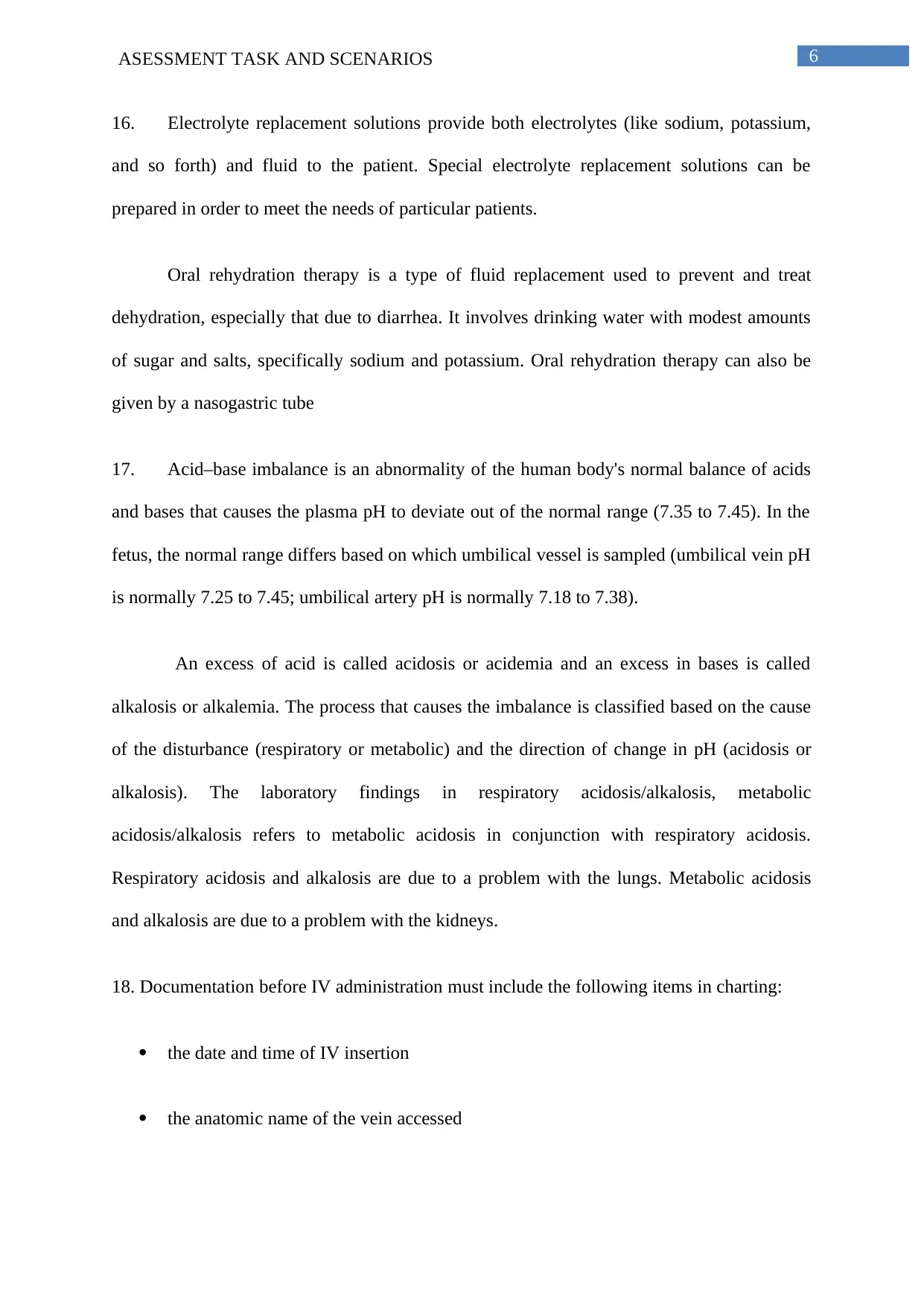
6ASESSMENT TASK AND SCENARIOS
16. Electrolyte replacement solutions provide both electrolytes (like sodium, potassium,
and so forth) and fluid to the patient. Special electrolyte replacement solutions can be
prepared in order to meet the needs of particular patients.
Oral rehydration therapy is a type of fluid replacement used to prevent and treat
dehydration, especially that due to diarrhea. It involves drinking water with modest amounts
of sugar and salts, specifically sodium and potassium. Oral rehydration therapy can also be
given by a nasogastric tube
17. Acid–base imbalance is an abnormality of the human body's normal balance of acids
and bases that causes the plasma pH to deviate out of the normal range (7.35 to 7.45). In the
fetus, the normal range differs based on which umbilical vessel is sampled (umbilical vein pH
is normally 7.25 to 7.45; umbilical artery pH is normally 7.18 to 7.38).
An excess of acid is called acidosis or acidemia and an excess in bases is called
alkalosis or alkalemia. The process that causes the imbalance is classified based on the cause
of the disturbance (respiratory or metabolic) and the direction of change in pH (acidosis or
alkalosis). The laboratory findings in respiratory acidosis/alkalosis, metabolic
acidosis/alkalosis refers to metabolic acidosis in conjunction with respiratory acidosis.
Respiratory acidosis and alkalosis are due to a problem with the lungs. Metabolic acidosis
and alkalosis are due to a problem with the kidneys.
18. Documentation before IV administration must include the following items in charting:
the date and time of IV insertion
the anatomic name of the vein accessed
16. Electrolyte replacement solutions provide both electrolytes (like sodium, potassium,
and so forth) and fluid to the patient. Special electrolyte replacement solutions can be
prepared in order to meet the needs of particular patients.
Oral rehydration therapy is a type of fluid replacement used to prevent and treat
dehydration, especially that due to diarrhea. It involves drinking water with modest amounts
of sugar and salts, specifically sodium and potassium. Oral rehydration therapy can also be
given by a nasogastric tube
17. Acid–base imbalance is an abnormality of the human body's normal balance of acids
and bases that causes the plasma pH to deviate out of the normal range (7.35 to 7.45). In the
fetus, the normal range differs based on which umbilical vessel is sampled (umbilical vein pH
is normally 7.25 to 7.45; umbilical artery pH is normally 7.18 to 7.38).
An excess of acid is called acidosis or acidemia and an excess in bases is called
alkalosis or alkalemia. The process that causes the imbalance is classified based on the cause
of the disturbance (respiratory or metabolic) and the direction of change in pH (acidosis or
alkalosis). The laboratory findings in respiratory acidosis/alkalosis, metabolic
acidosis/alkalosis refers to metabolic acidosis in conjunction with respiratory acidosis.
Respiratory acidosis and alkalosis are due to a problem with the lungs. Metabolic acidosis
and alkalosis are due to a problem with the kidneys.
18. Documentation before IV administration must include the following items in charting:
the date and time of IV insertion
the anatomic name of the vein accessed
Paraphrase This Document
Need a fresh take? Get an instant paraphrase of this document with our AI Paraphraser
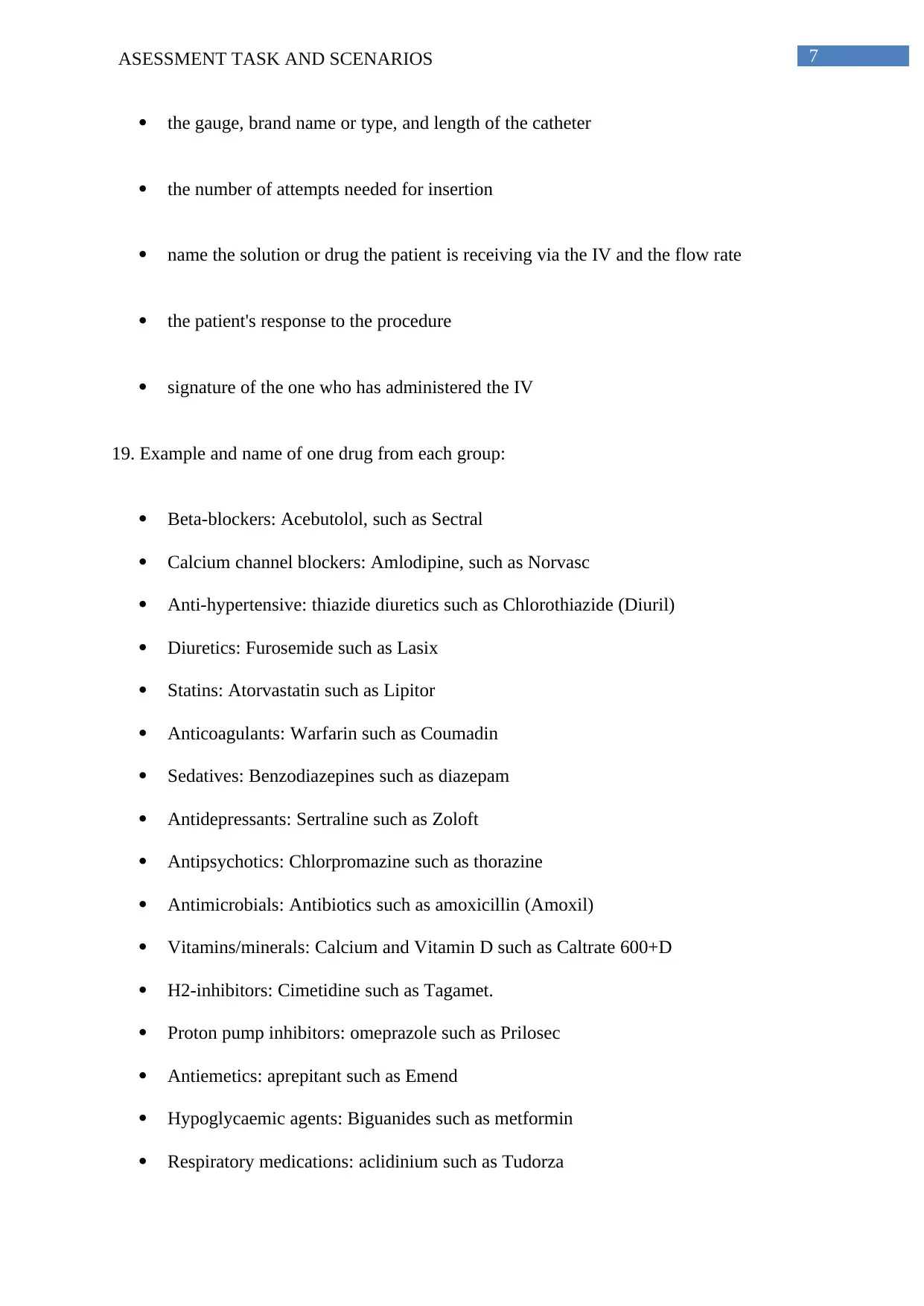
7ASESSMENT TASK AND SCENARIOS
the gauge, brand name or type, and length of the catheter
the number of attempts needed for insertion
name the solution or drug the patient is receiving via the IV and the flow rate
the patient's response to the procedure
signature of the one who has administered the IV
19. Example and name of one drug from each group:
Beta-blockers: Acebutolol, such as Sectral
Calcium channel blockers: Amlodipine, such as Norvasc
Anti-hypertensive: thiazide diuretics such as Chlorothiazide (Diuril)
Diuretics: Furosemide such as Lasix
Statins: Atorvastatin such as Lipitor
Anticoagulants: Warfarin such as Coumadin
Sedatives: Benzodiazepines such as diazepam
Antidepressants: Sertraline such as Zoloft
Antipsychotics: Chlorpromazine such as thorazine
Antimicrobials: Antibiotics such as amoxicillin (Amoxil)
Vitamins/minerals: Calcium and Vitamin D such as Caltrate 600+D
H2-inhibitors: Cimetidine such as Tagamet.
Proton pump inhibitors: omeprazole such as Prilosec
Antiemetics: aprepitant such as Emend
Hypoglycaemic agents: Biguanides such as metformin
Respiratory medications: aclidinium such as Tudorza
the gauge, brand name or type, and length of the catheter
the number of attempts needed for insertion
name the solution or drug the patient is receiving via the IV and the flow rate
the patient's response to the procedure
signature of the one who has administered the IV
19. Example and name of one drug from each group:
Beta-blockers: Acebutolol, such as Sectral
Calcium channel blockers: Amlodipine, such as Norvasc
Anti-hypertensive: thiazide diuretics such as Chlorothiazide (Diuril)
Diuretics: Furosemide such as Lasix
Statins: Atorvastatin such as Lipitor
Anticoagulants: Warfarin such as Coumadin
Sedatives: Benzodiazepines such as diazepam
Antidepressants: Sertraline such as Zoloft
Antipsychotics: Chlorpromazine such as thorazine
Antimicrobials: Antibiotics such as amoxicillin (Amoxil)
Vitamins/minerals: Calcium and Vitamin D such as Caltrate 600+D
H2-inhibitors: Cimetidine such as Tagamet.
Proton pump inhibitors: omeprazole such as Prilosec
Antiemetics: aprepitant such as Emend
Hypoglycaemic agents: Biguanides such as metformin
Respiratory medications: aclidinium such as Tudorza
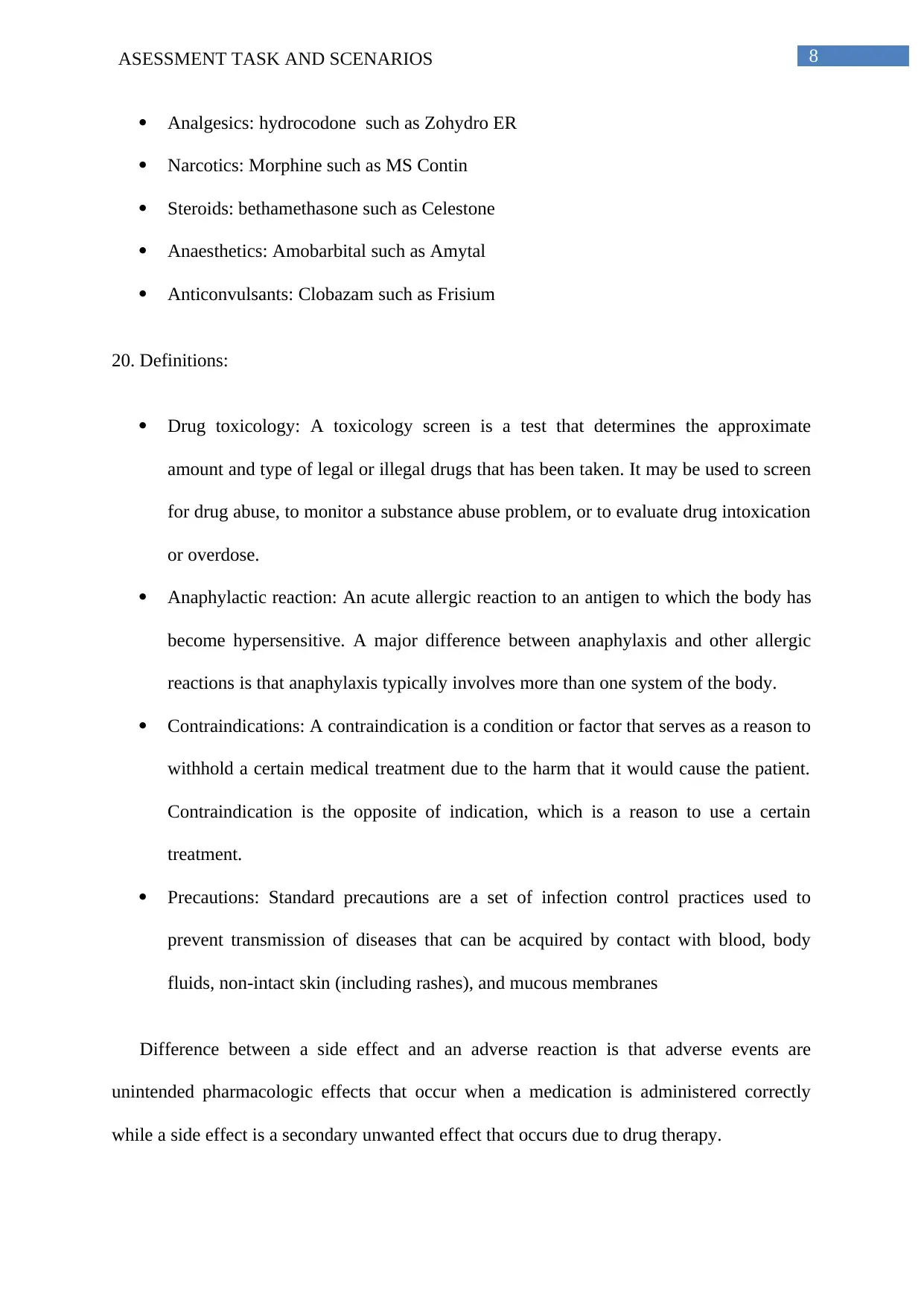
8ASESSMENT TASK AND SCENARIOS
Analgesics: hydrocodone such as Zohydro ER
Narcotics: Morphine such as MS Contin
Steroids: bethamethasone such as Celestone
Anaesthetics: Amobarbital such as Amytal
Anticonvulsants: Clobazam such as Frisium
20. Definitions:
Drug toxicology: A toxicology screen is a test that determines the approximate
amount and type of legal or illegal drugs that has been taken. It may be used to screen
for drug abuse, to monitor a substance abuse problem, or to evaluate drug intoxication
or overdose.
Anaphylactic reaction: An acute allergic reaction to an antigen to which the body has
become hypersensitive. A major difference between anaphylaxis and other allergic
reactions is that anaphylaxis typically involves more than one system of the body.
Contraindications: A contraindication is a condition or factor that serves as a reason to
withhold a certain medical treatment due to the harm that it would cause the patient.
Contraindication is the opposite of indication, which is a reason to use a certain
treatment.
Precautions: Standard precautions are a set of infection control practices used to
prevent transmission of diseases that can be acquired by contact with blood, body
fluids, non-intact skin (including rashes), and mucous membranes
Difference between a side effect and an adverse reaction is that adverse events are
unintended pharmacologic effects that occur when a medication is administered correctly
while a side effect is a secondary unwanted effect that occurs due to drug therapy.
Analgesics: hydrocodone such as Zohydro ER
Narcotics: Morphine such as MS Contin
Steroids: bethamethasone such as Celestone
Anaesthetics: Amobarbital such as Amytal
Anticonvulsants: Clobazam such as Frisium
20. Definitions:
Drug toxicology: A toxicology screen is a test that determines the approximate
amount and type of legal or illegal drugs that has been taken. It may be used to screen
for drug abuse, to monitor a substance abuse problem, or to evaluate drug intoxication
or overdose.
Anaphylactic reaction: An acute allergic reaction to an antigen to which the body has
become hypersensitive. A major difference between anaphylaxis and other allergic
reactions is that anaphylaxis typically involves more than one system of the body.
Contraindications: A contraindication is a condition or factor that serves as a reason to
withhold a certain medical treatment due to the harm that it would cause the patient.
Contraindication is the opposite of indication, which is a reason to use a certain
treatment.
Precautions: Standard precautions are a set of infection control practices used to
prevent transmission of diseases that can be acquired by contact with blood, body
fluids, non-intact skin (including rashes), and mucous membranes
Difference between a side effect and an adverse reaction is that adverse events are
unintended pharmacologic effects that occur when a medication is administered correctly
while a side effect is a secondary unwanted effect that occurs due to drug therapy.
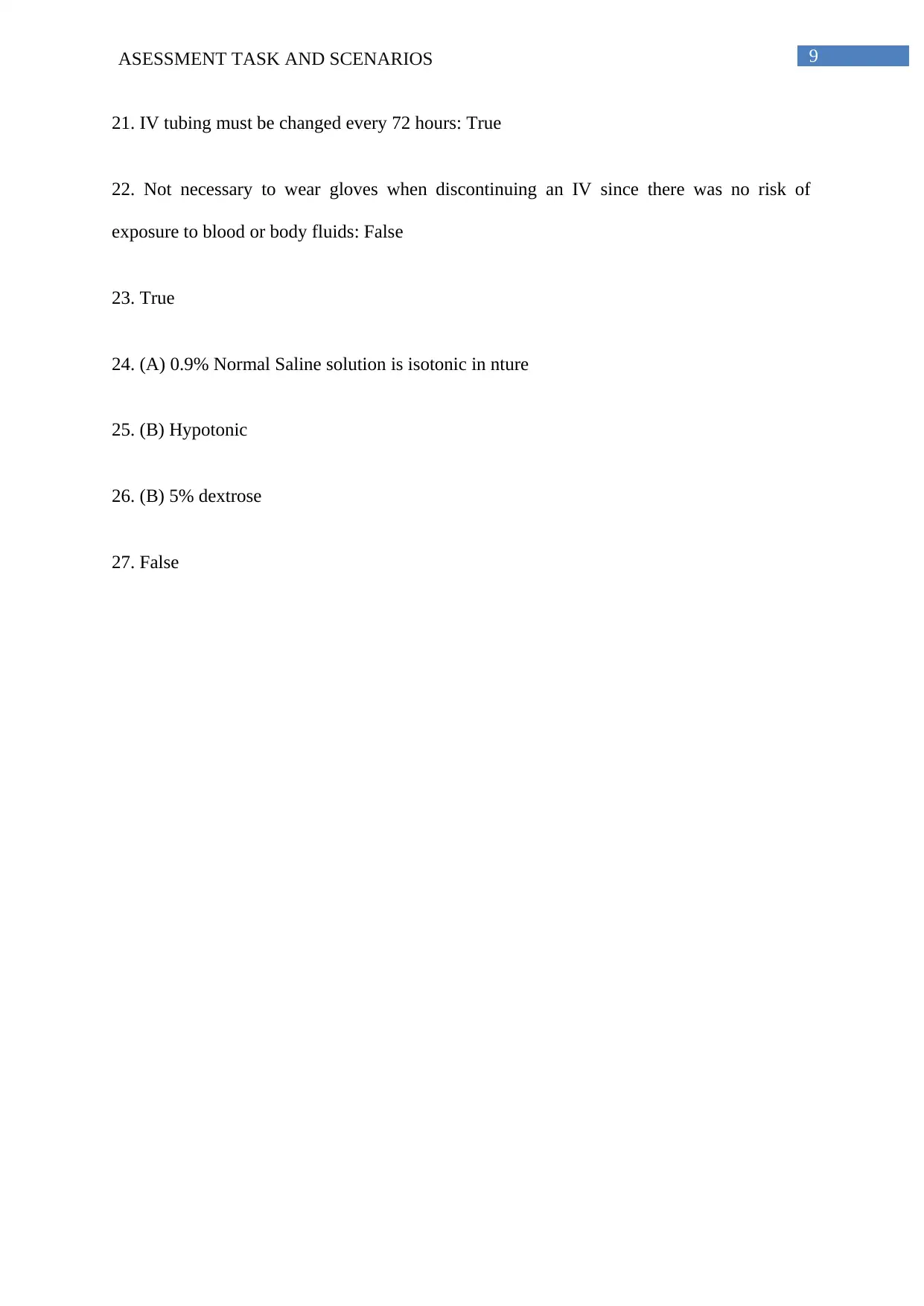
9ASESSMENT TASK AND SCENARIOS
21. IV tubing must be changed every 72 hours: True
22. Not necessary to wear gloves when discontinuing an IV since there was no risk of
exposure to blood or body fluids: False
23. True
24. (A) 0.9% Normal Saline solution is isotonic in nture
25. (B) Hypotonic
26. (B) 5% dextrose
27. False
21. IV tubing must be changed every 72 hours: True
22. Not necessary to wear gloves when discontinuing an IV since there was no risk of
exposure to blood or body fluids: False
23. True
24. (A) 0.9% Normal Saline solution is isotonic in nture
25. (B) Hypotonic
26. (B) 5% dextrose
27. False
Secure Best Marks with AI Grader
Need help grading? Try our AI Grader for instant feedback on your assignments.

10ASESSMENT TASK AND SCENARIOS
Scenario 1
Legal implications:
Theo is an enrolled nurse who facilitates and contributes to the healthcare plan of the
patient whereas May is the registered nurse assigned to the patient. May has prepared the IV
amoxicillin medication for Theo to administer who is an enrolled nurse, but leaves for her
morning break. Thus, Theo is supposed to administer the IV amoxicillin on his own without
any supervision and this medication he did not prepare. In this scenario, Theo himself must
have prepared the medication and administered the same with May’s guidance. If May
documents the medication as given, then it is falsifying data entry in the patient’s medical
record. Falsification of any record is a serious allegation that can result in an employee being
terminated or reported to the state board of nursing.
Patients are unintentionally harmed in up to 25% of hospital admissions, and
medication incidents account for a large proportion of these adverse events. The article by
Lowe, 2017 includes a healthy opioid-naive 22-year-old man who has been admitted to
hospital with acute upper back pain. Morphine was initially ordered at 1–5 mg intravenously
every 2 hours as needed, and was later increased to 5–10 mg intravenously every 2 hours as
needed. Owing to poor pain control, an order was written in the evening to discontinue
morphine and start hydromorphone at 5–10 mg intravenously every 4 hours as needed. The
next morning, the patient was found without vital signs. Resuscitation efforts were
unsuccessful. This illustrates the importance of reporting and analyzing suspected medication
errors to detect vulnerabilities in practices, design preventive strategies and inform future
research, including studies of interventions to prevent fatalities.
Scenario 1
Legal implications:
Theo is an enrolled nurse who facilitates and contributes to the healthcare plan of the
patient whereas May is the registered nurse assigned to the patient. May has prepared the IV
amoxicillin medication for Theo to administer who is an enrolled nurse, but leaves for her
morning break. Thus, Theo is supposed to administer the IV amoxicillin on his own without
any supervision and this medication he did not prepare. In this scenario, Theo himself must
have prepared the medication and administered the same with May’s guidance. If May
documents the medication as given, then it is falsifying data entry in the patient’s medical
record. Falsification of any record is a serious allegation that can result in an employee being
terminated or reported to the state board of nursing.
Patients are unintentionally harmed in up to 25% of hospital admissions, and
medication incidents account for a large proportion of these adverse events. The article by
Lowe, 2017 includes a healthy opioid-naive 22-year-old man who has been admitted to
hospital with acute upper back pain. Morphine was initially ordered at 1–5 mg intravenously
every 2 hours as needed, and was later increased to 5–10 mg intravenously every 2 hours as
needed. Owing to poor pain control, an order was written in the evening to discontinue
morphine and start hydromorphone at 5–10 mg intravenously every 4 hours as needed. The
next morning, the patient was found without vital signs. Resuscitation efforts were
unsuccessful. This illustrates the importance of reporting and analyzing suspected medication
errors to detect vulnerabilities in practices, design preventive strategies and inform future
research, including studies of interventions to prevent fatalities.
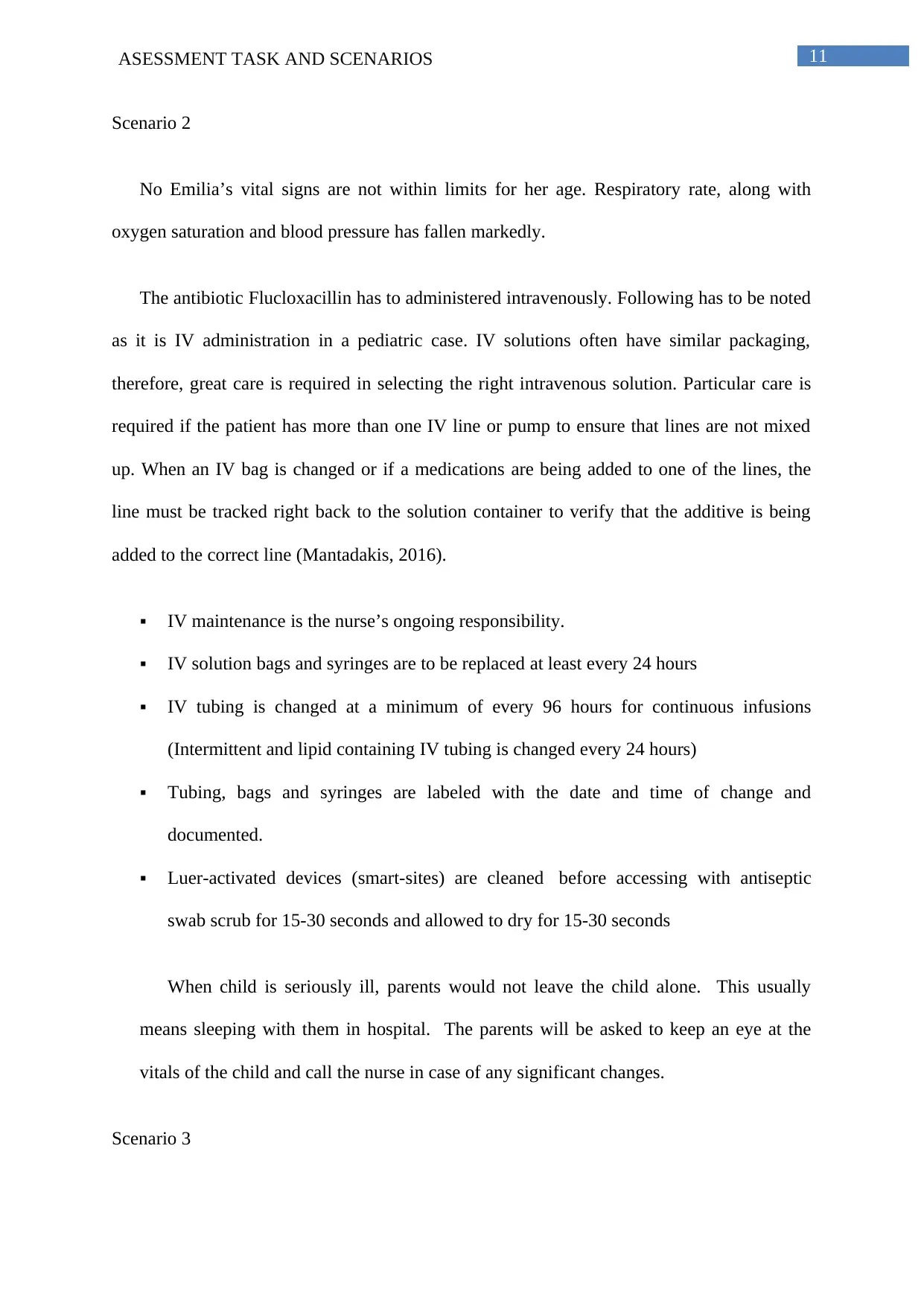
11ASESSMENT TASK AND SCENARIOS
Scenario 2
No Emilia’s vital signs are not within limits for her age. Respiratory rate, along with
oxygen saturation and blood pressure has fallen markedly.
The antibiotic Flucloxacillin has to administered intravenously. Following has to be noted
as it is IV administration in a pediatric case. IV solutions often have similar packaging,
therefore, great care is required in selecting the right intravenous solution. Particular care is
required if the patient has more than one IV line or pump to ensure that lines are not mixed
up. When an IV bag is changed or if a medications are being added to one of the lines, the
line must be tracked right back to the solution container to verify that the additive is being
added to the correct line (Mantadakis, 2016).
IV maintenance is the nurse’s ongoing responsibility.
IV solution bags and syringes are to be replaced at least every 24 hours
IV tubing is changed at a minimum of every 96 hours for continuous infusions
(Intermittent and lipid containing IV tubing is changed every 24 hours)
Tubing, bags and syringes are labeled with the date and time of change and
documented.
Luer-activated devices (smart-sites) are cleaned before accessing with antiseptic
swab scrub for 15-30 seconds and allowed to dry for 15-30 seconds
When child is seriously ill, parents would not leave the child alone. This usually
means sleeping with them in hospital. The parents will be asked to keep an eye at the
vitals of the child and call the nurse in case of any significant changes.
Scenario 3
Scenario 2
No Emilia’s vital signs are not within limits for her age. Respiratory rate, along with
oxygen saturation and blood pressure has fallen markedly.
The antibiotic Flucloxacillin has to administered intravenously. Following has to be noted
as it is IV administration in a pediatric case. IV solutions often have similar packaging,
therefore, great care is required in selecting the right intravenous solution. Particular care is
required if the patient has more than one IV line or pump to ensure that lines are not mixed
up. When an IV bag is changed or if a medications are being added to one of the lines, the
line must be tracked right back to the solution container to verify that the additive is being
added to the correct line (Mantadakis, 2016).
IV maintenance is the nurse’s ongoing responsibility.
IV solution bags and syringes are to be replaced at least every 24 hours
IV tubing is changed at a minimum of every 96 hours for continuous infusions
(Intermittent and lipid containing IV tubing is changed every 24 hours)
Tubing, bags and syringes are labeled with the date and time of change and
documented.
Luer-activated devices (smart-sites) are cleaned before accessing with antiseptic
swab scrub for 15-30 seconds and allowed to dry for 15-30 seconds
When child is seriously ill, parents would not leave the child alone. This usually
means sleeping with them in hospital. The parents will be asked to keep an eye at the
vitals of the child and call the nurse in case of any significant changes.
Scenario 3
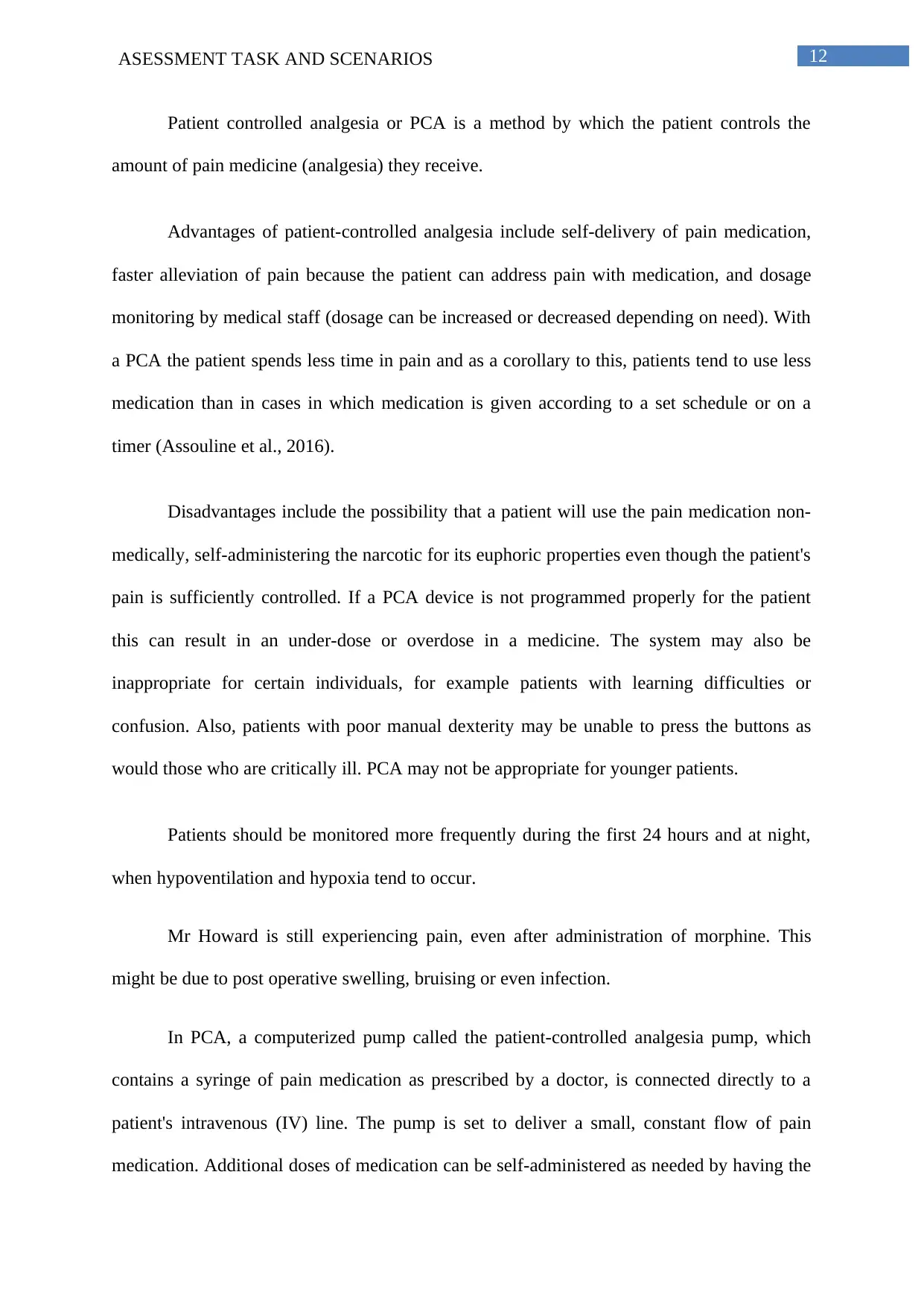
12ASESSMENT TASK AND SCENARIOS
Patient controlled analgesia or PCA is a method by which the patient controls the
amount of pain medicine (analgesia) they receive.
Advantages of patient-controlled analgesia include self-delivery of pain medication,
faster alleviation of pain because the patient can address pain with medication, and dosage
monitoring by medical staff (dosage can be increased or decreased depending on need). With
a PCA the patient spends less time in pain and as a corollary to this, patients tend to use less
medication than in cases in which medication is given according to a set schedule or on a
timer (Assouline et al., 2016).
Disadvantages include the possibility that a patient will use the pain medication non-
medically, self-administering the narcotic for its euphoric properties even though the patient's
pain is sufficiently controlled. If a PCA device is not programmed properly for the patient
this can result in an under-dose or overdose in a medicine. The system may also be
inappropriate for certain individuals, for example patients with learning difficulties or
confusion. Also, patients with poor manual dexterity may be unable to press the buttons as
would those who are critically ill. PCA may not be appropriate for younger patients.
Patients should be monitored more frequently during the first 24 hours and at night,
when hypoventilation and hypoxia tend to occur.
Mr Howard is still experiencing pain, even after administration of morphine. This
might be due to post operative swelling, bruising or even infection.
In PCA, a computerized pump called the patient-controlled analgesia pump, which
contains a syringe of pain medication as prescribed by a doctor, is connected directly to a
patient's intravenous (IV) line. The pump is set to deliver a small, constant flow of pain
medication. Additional doses of medication can be self-administered as needed by having the
Patient controlled analgesia or PCA is a method by which the patient controls the
amount of pain medicine (analgesia) they receive.
Advantages of patient-controlled analgesia include self-delivery of pain medication,
faster alleviation of pain because the patient can address pain with medication, and dosage
monitoring by medical staff (dosage can be increased or decreased depending on need). With
a PCA the patient spends less time in pain and as a corollary to this, patients tend to use less
medication than in cases in which medication is given according to a set schedule or on a
timer (Assouline et al., 2016).
Disadvantages include the possibility that a patient will use the pain medication non-
medically, self-administering the narcotic for its euphoric properties even though the patient's
pain is sufficiently controlled. If a PCA device is not programmed properly for the patient
this can result in an under-dose or overdose in a medicine. The system may also be
inappropriate for certain individuals, for example patients with learning difficulties or
confusion. Also, patients with poor manual dexterity may be unable to press the buttons as
would those who are critically ill. PCA may not be appropriate for younger patients.
Patients should be monitored more frequently during the first 24 hours and at night,
when hypoventilation and hypoxia tend to occur.
Mr Howard is still experiencing pain, even after administration of morphine. This
might be due to post operative swelling, bruising or even infection.
In PCA, a computerized pump called the patient-controlled analgesia pump, which
contains a syringe of pain medication as prescribed by a doctor, is connected directly to a
patient's intravenous (IV) line. The pump is set to deliver a small, constant flow of pain
medication. Additional doses of medication can be self-administered as needed by having the
Paraphrase This Document
Need a fresh take? Get an instant paraphrase of this document with our AI Paraphraser
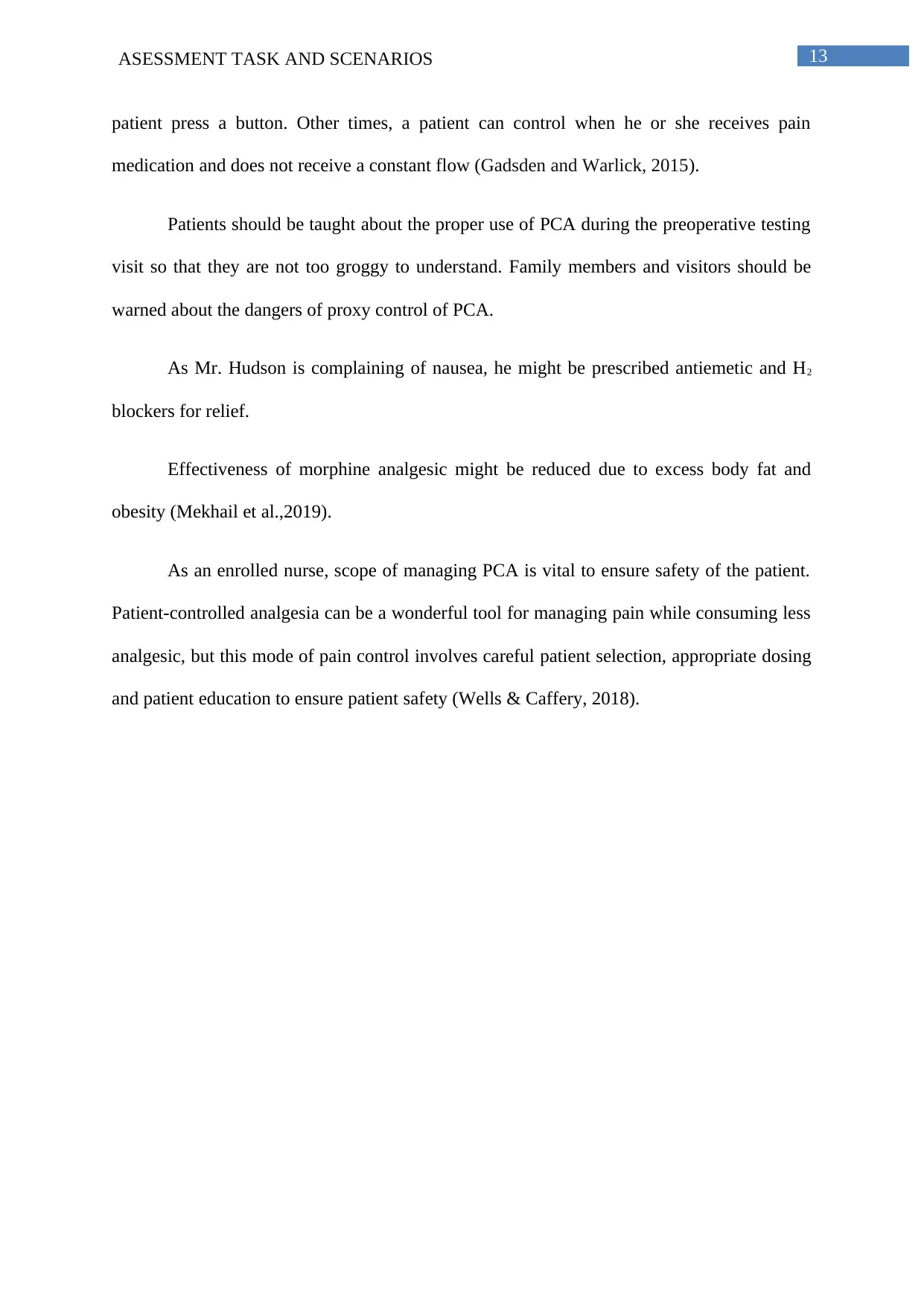
13ASESSMENT TASK AND SCENARIOS
patient press a button. Other times, a patient can control when he or she receives pain
medication and does not receive a constant flow (Gadsden and Warlick, 2015).
Patients should be taught about the proper use of PCA during the preoperative testing
visit so that they are not too groggy to understand. Family members and visitors should be
warned about the dangers of proxy control of PCA.
As Mr. Hudson is complaining of nausea, he might be prescribed antiemetic and H2
blockers for relief.
Effectiveness of morphine analgesic might be reduced due to excess body fat and
obesity (Mekhail et al.,2019).
As an enrolled nurse, scope of managing PCA is vital to ensure safety of the patient.
Patient-controlled analgesia can be a wonderful tool for managing pain while consuming less
analgesic, but this mode of pain control involves careful patient selection, appropriate dosing
and patient education to ensure patient safety (Wells & Caffery, 2018).
patient press a button. Other times, a patient can control when he or she receives pain
medication and does not receive a constant flow (Gadsden and Warlick, 2015).
Patients should be taught about the proper use of PCA during the preoperative testing
visit so that they are not too groggy to understand. Family members and visitors should be
warned about the dangers of proxy control of PCA.
As Mr. Hudson is complaining of nausea, he might be prescribed antiemetic and H2
blockers for relief.
Effectiveness of morphine analgesic might be reduced due to excess body fat and
obesity (Mekhail et al.,2019).
As an enrolled nurse, scope of managing PCA is vital to ensure safety of the patient.
Patient-controlled analgesia can be a wonderful tool for managing pain while consuming less
analgesic, but this mode of pain control involves careful patient selection, appropriate dosing
and patient education to ensure patient safety (Wells & Caffery, 2018).
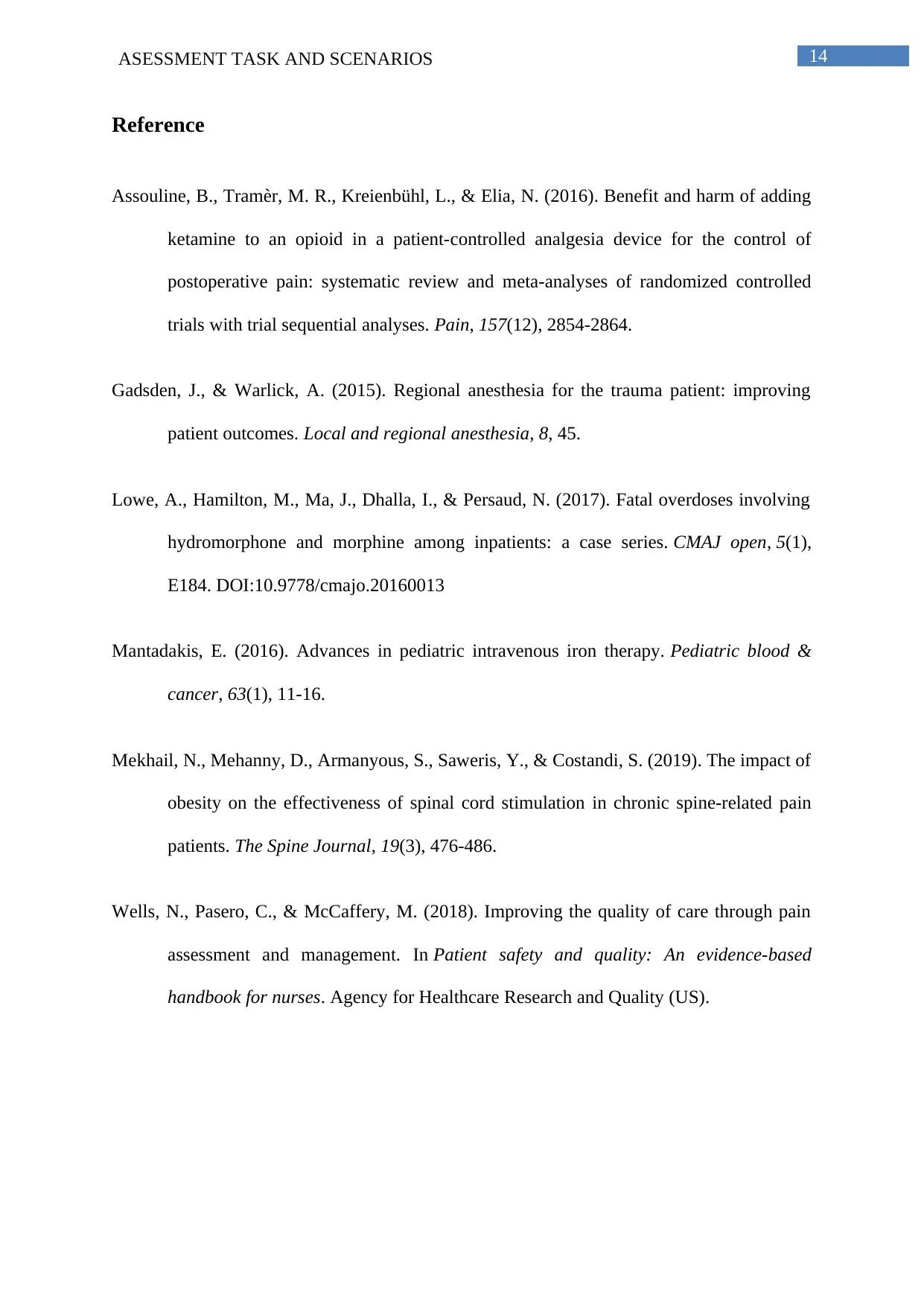
14ASESSMENT TASK AND SCENARIOS
Reference
Assouline, B., Tramèr, M. R., Kreienbühl, L., & Elia, N. (2016). Benefit and harm of adding
ketamine to an opioid in a patient-controlled analgesia device for the control of
postoperative pain: systematic review and meta-analyses of randomized controlled
trials with trial sequential analyses. Pain, 157(12), 2854-2864.
Gadsden, J., & Warlick, A. (2015). Regional anesthesia for the trauma patient: improving
patient outcomes. Local and regional anesthesia, 8, 45.
Lowe, A., Hamilton, M., Ma, J., Dhalla, I., & Persaud, N. (2017). Fatal overdoses involving
hydromorphone and morphine among inpatients: a case series. CMAJ open, 5(1),
E184. DOI:10.9778/cmajo.20160013
Mantadakis, E. (2016). Advances in pediatric intravenous iron therapy. Pediatric blood &
cancer, 63(1), 11-16.
Mekhail, N., Mehanny, D., Armanyous, S., Saweris, Y., & Costandi, S. (2019). The impact of
obesity on the effectiveness of spinal cord stimulation in chronic spine-related pain
patients. The Spine Journal, 19(3), 476-486.
Wells, N., Pasero, C., & McCaffery, M. (2018). Improving the quality of care through pain
assessment and management. In Patient safety and quality: An evidence-based
handbook for nurses. Agency for Healthcare Research and Quality (US).
Reference
Assouline, B., Tramèr, M. R., Kreienbühl, L., & Elia, N. (2016). Benefit and harm of adding
ketamine to an opioid in a patient-controlled analgesia device for the control of
postoperative pain: systematic review and meta-analyses of randomized controlled
trials with trial sequential analyses. Pain, 157(12), 2854-2864.
Gadsden, J., & Warlick, A. (2015). Regional anesthesia for the trauma patient: improving
patient outcomes. Local and regional anesthesia, 8, 45.
Lowe, A., Hamilton, M., Ma, J., Dhalla, I., & Persaud, N. (2017). Fatal overdoses involving
hydromorphone and morphine among inpatients: a case series. CMAJ open, 5(1),
E184. DOI:10.9778/cmajo.20160013
Mantadakis, E. (2016). Advances in pediatric intravenous iron therapy. Pediatric blood &
cancer, 63(1), 11-16.
Mekhail, N., Mehanny, D., Armanyous, S., Saweris, Y., & Costandi, S. (2019). The impact of
obesity on the effectiveness of spinal cord stimulation in chronic spine-related pain
patients. The Spine Journal, 19(3), 476-486.
Wells, N., Pasero, C., & McCaffery, M. (2018). Improving the quality of care through pain
assessment and management. In Patient safety and quality: An evidence-based
handbook for nurses. Agency for Healthcare Research and Quality (US).
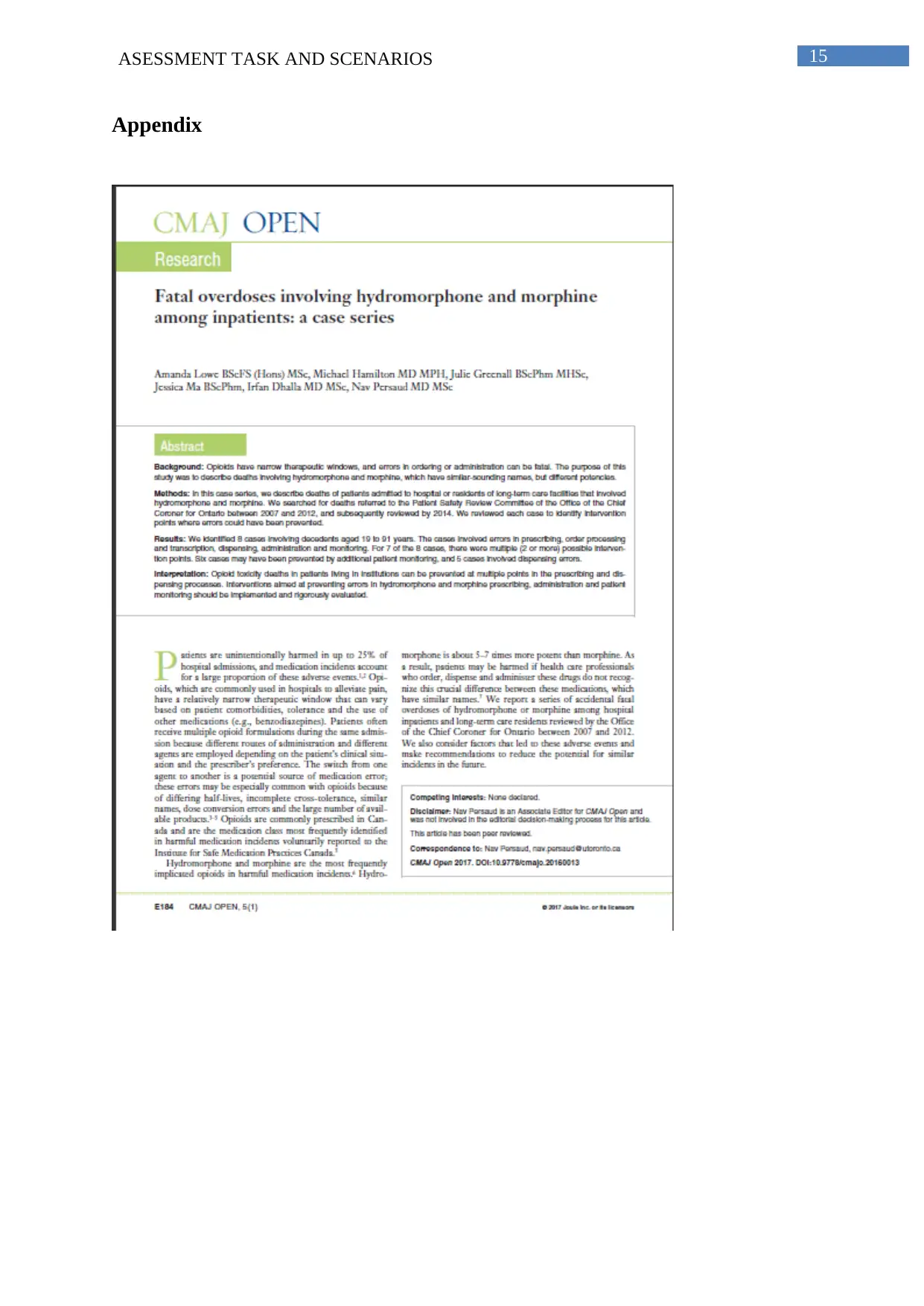
15ASESSMENT TASK AND SCENARIOS
Appendix
Appendix
Secure Best Marks with AI Grader
Need help grading? Try our AI Grader for instant feedback on your assignments.

16ASESSMENT TASK AND SCENARIOS

17ASESSMENT TASK AND SCENARIOS
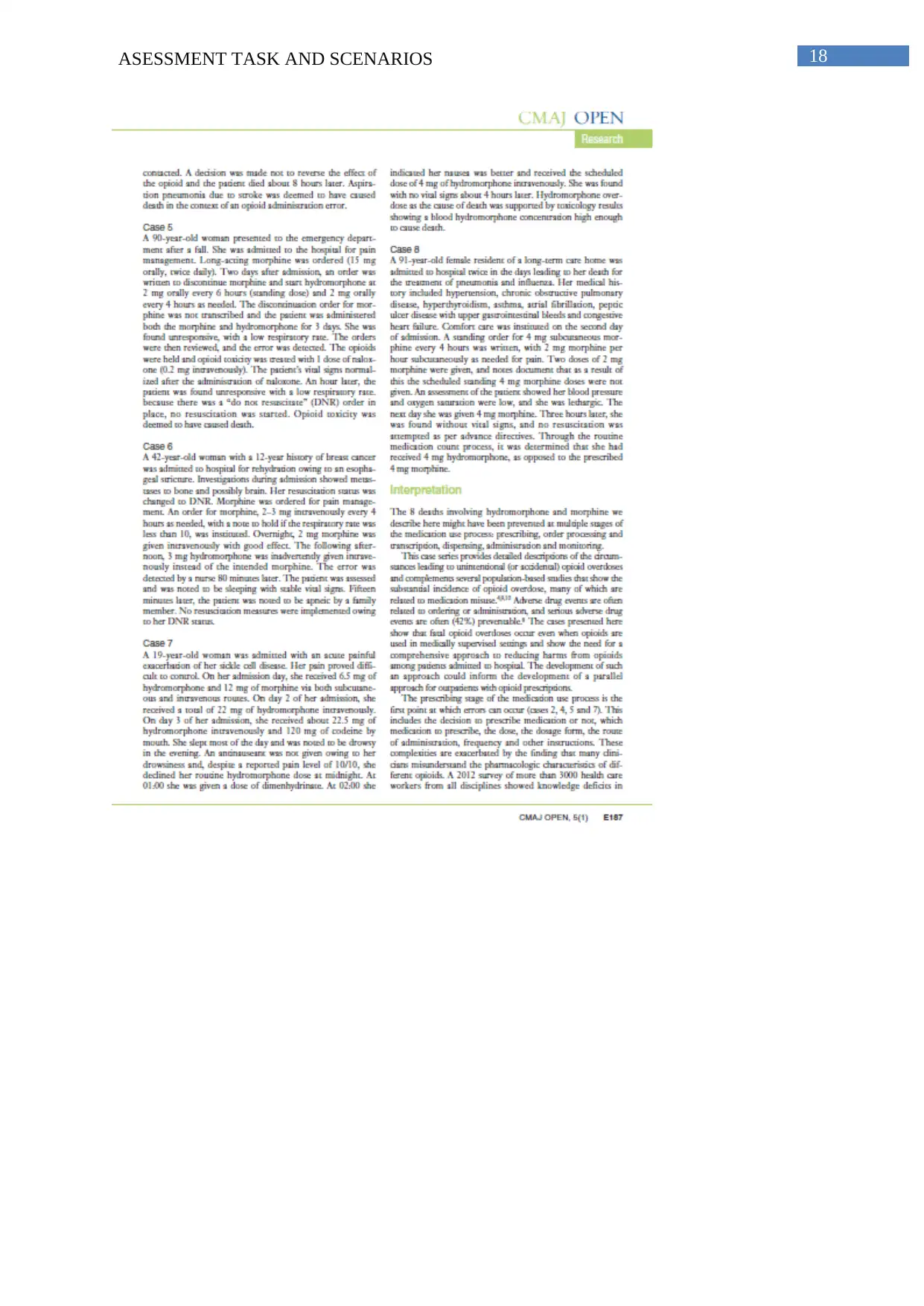
18ASESSMENT TASK AND SCENARIOS
Paraphrase This Document
Need a fresh take? Get an instant paraphrase of this document with our AI Paraphraser
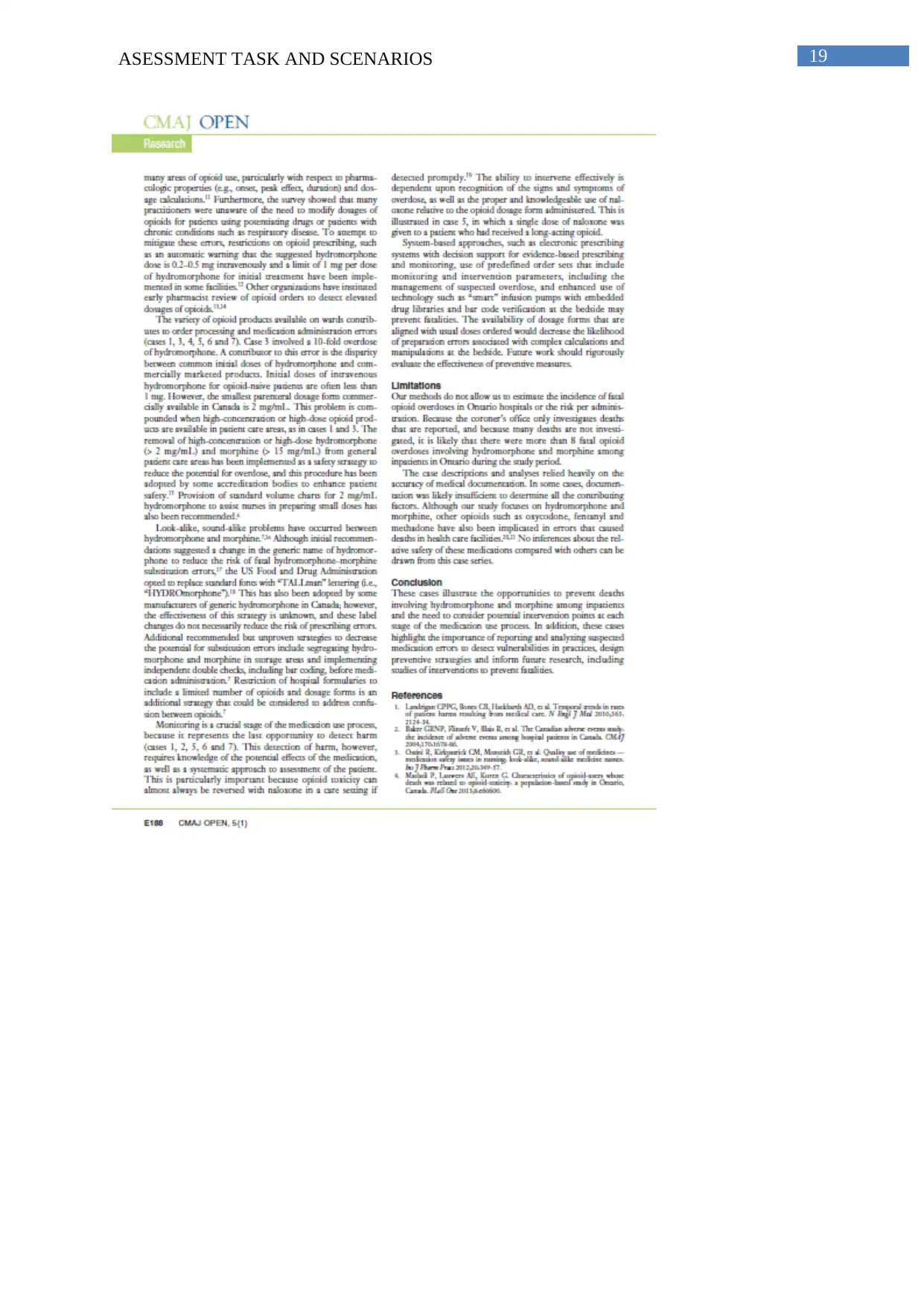
19ASESSMENT TASK AND SCENARIOS
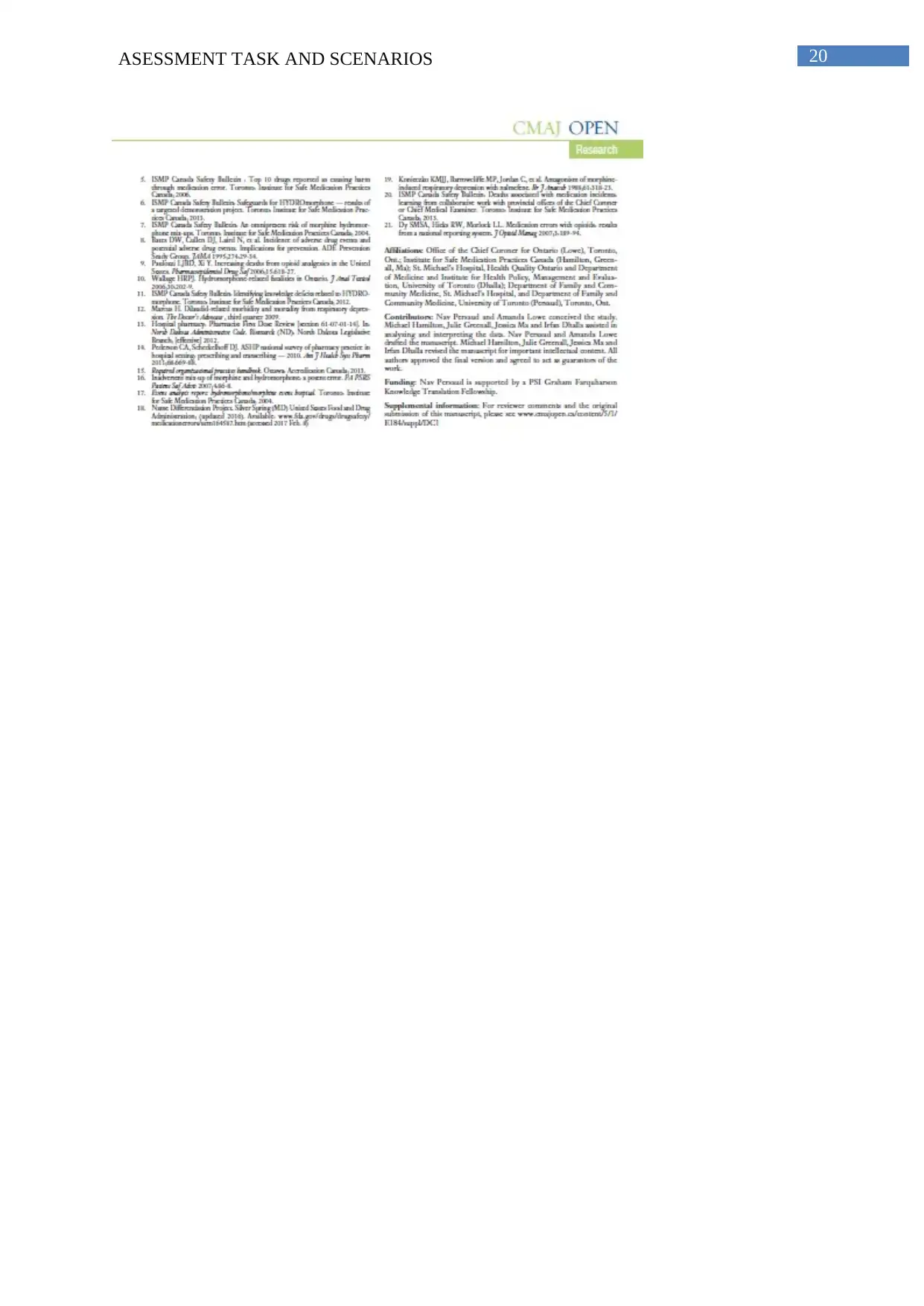
20ASESSMENT TASK AND SCENARIOS
1 out of 21
Your All-in-One AI-Powered Toolkit for Academic Success.
+13062052269
info@desklib.com
Available 24*7 on WhatsApp / Email
![[object Object]](/_next/static/media/star-bottom.7253800d.svg)
Unlock your academic potential
© 2024 | Zucol Services PVT LTD | All rights reserved.

